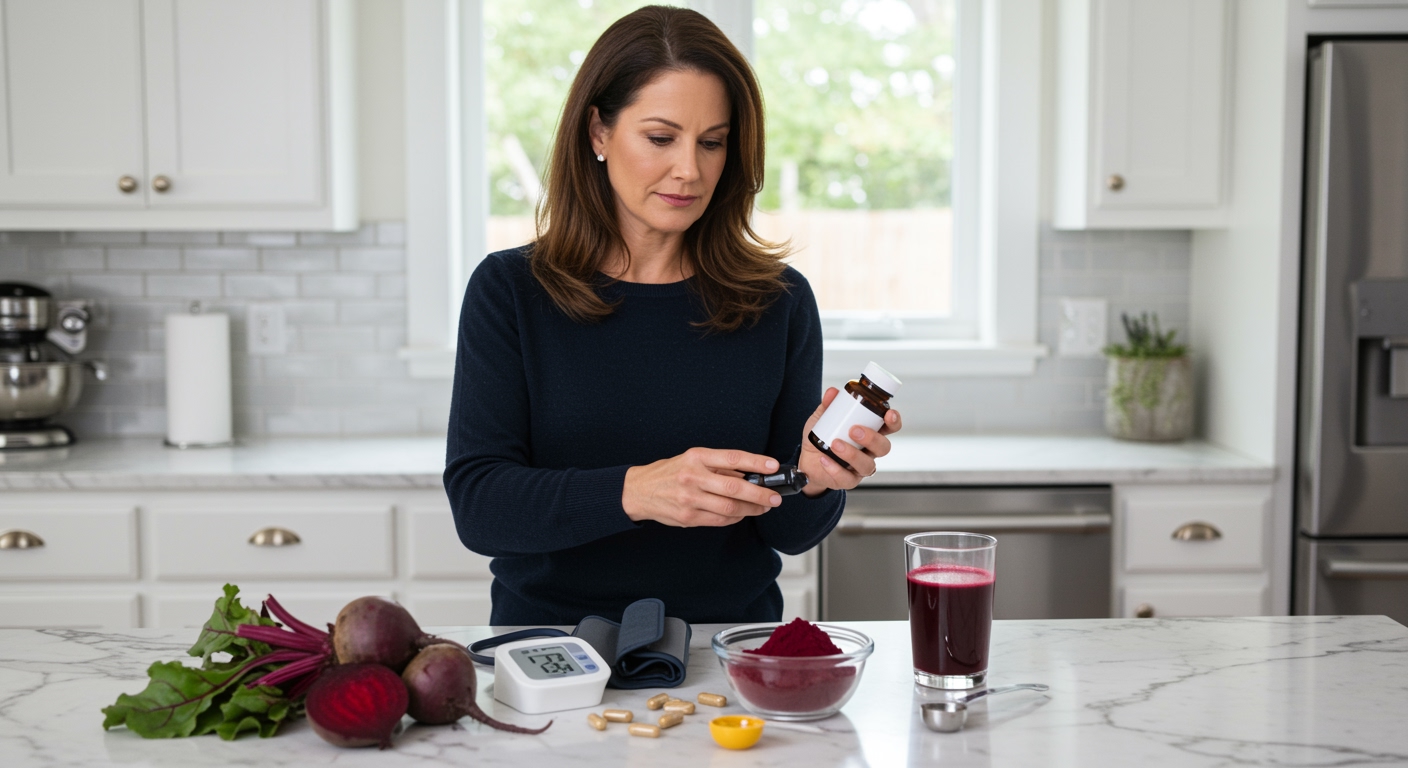✪ Key Takeaway: Pinto beans effectively lower blood pressure through high potassium, magnesium, and fiber content that supports healthy circulation.
Introduction
Your doctor just told you that your blood pressure numbers are climbing into dangerous territory.
You might be wondering if simple dietary changes can make a real difference before you need medication. Many people search for natural ways to manage their blood pressure because they want to avoid the side effects and costs of prescription drugs.
Hi, I am Abdur, your nutrition coach and today I am going to explain how pinto beans can become your secret weapon against high blood pressure.
What Makes Pinto Beans So Effective Against High Blood Pressure?
Pinto beans contain a powerful combination of nutrients that work together to lower your blood pressure naturally.
One cup of cooked pinto beans delivers about 746 milligrams of potassium, which is roughly 16% of your daily needs. This mineral acts like a natural diuretic in your body, helping your kidneys flush out excess sodium that causes blood pressure spikes.
The magnesium content in pinto beans also plays a crucial role in blood pressure regulation. Each serving provides approximately 86 milligrams of magnesium, which helps relax your blood vessel walls and improves blood flow throughout your body.
Research published in the Journal of the American College of Nutrition found that people who ate pinto beans regularly showed significant improvements in their systolic blood pressure readings. The study participants experienced an average reduction of 3.4 mmHg in their systolic pressure after just eight weeks.
The soluble fiber in pinto beans creates another pathway for blood pressure reduction. This fiber helps remove cholesterol from your bloodstream, which reduces the workload on your heart and allows blood to flow more easily through your arteries.
Pinto beans also contain compounds called flavonoids that act as natural antioxidants. These substances protect your blood vessels from damage caused by free radicals and help maintain the flexibility of your arterial walls.
✪ Fact: Pinto beans contain more potassium per serving than a medium banana, making them superior for blood pressure control.
How Much Should You Eat For Maximum Blood Pressure Benefits?
The optimal amount of pinto beans for blood pressure management is half a cup of cooked beans consumed three to four times per week.
This serving size provides approximately 373 milligrams of potassium and 43 milligrams of magnesium without overloading your digestive system. Starting with smaller portions helps your body adjust to the increased fiber intake and prevents uncomfortable bloating or gas.
Clinical studies show that consuming legumes four times weekly produces measurable improvements in cardiovascular health markers. The participants who followed this pattern experienced better blood pressure control compared to those who ate beans less frequently.
You can spread your pinto bean consumption throughout the week by adding them to salads, soups, or as a side dish with your main meals. The key is consistency rather than quantity because your body needs regular exposure to these nutrients to maintain stable blood pressure levels.
Timing also matters when it comes to maximizing the blood pressure benefits. Eating pinto beans with meals that contain high sodium foods helps counteract the sodium effects through the potassium content.
Remember that preparation methods can affect the nutritional value of your pinto beans. Cooking them from dried beans without added salt preserves the maximum amount of beneficial minerals compared to canned varieties that often contain excess sodium.
✪ Pro Tip: Soak dried pinto beans overnight and cook them in batches to have blood pressure-friendly meals ready throughout the week.
What About People Taking Blood Pressure Medications?
Pinto beans are generally safe to eat while taking blood pressure medications, but you should monitor your readings more closely when adding them to your diet.
The potassium content in pinto beans can enhance the effects of certain blood pressure medications, particularly ACE inhibitors and diuretics. This interaction usually produces beneficial results, but it may require medication adjustments from your healthcare provider.
People taking potassium-sparing diuretics need to be especially careful because combining these medications with high-potassium foods like pinto beans can lead to hyperkalemia. This condition occurs when potassium levels become too high in your bloodstream and can cause dangerous heart rhythm problems.
If you take blood thinners like warfarin, pinto beans should not cause any significant interactions. However, the vitamin K content in pinto beans is relatively low compared to leafy greens, so they are unlikely to interfere with your medication effectiveness.
Always inform your doctor when you make significant dietary changes, especially if you plan to eat pinto beans regularly. Your healthcare provider may want to monitor your blood pressure more frequently during the first few weeks to ensure your medications remain properly balanced.
Some people experience better blood pressure control when combining pinto beans with their medications, which may allow for lower medication doses over time. However, never reduce or stop your medications without medical supervision, even if your blood pressure improves significantly.
✪ Note: Keep a food and blood pressure diary to track how pinto beans affect your readings when combined with medications.
Are There Any Side Effects Or Concerns With Pinto Beans?
Most people can eat pinto beans safely, but some individuals may experience digestive discomfort or other mild side effects.
The most common issue is intestinal gas production caused by oligosaccharides, which are complex sugars that your small intestine cannot fully digest. These sugars ferment in your large intestine, producing gas that can cause bloating and discomfort.
You can minimize gas production by soaking dried pinto beans for at least eight hours before cooking and discarding the soaking water. Adding digestive spices like cumin, fennel, or ginger to your bean dishes also helps reduce gas formation.
People with kidney disease should consult their healthcare provider before increasing pinto bean consumption because the high potassium content may not be appropriate for their condition. Damaged kidneys cannot effectively remove excess potassium from the bloodstream.
Individuals with gout may need to limit pinto bean intake because legumes contain moderate levels of purines. These compounds can trigger gout flares in sensitive people, although pinto beans are considered lower in purines compared to organ meats or certain seafood.
Some people experience allergic reactions to legumes, including pinto beans. Symptoms may include skin rashes, digestive upset, or respiratory problems. If you have known allergies to other beans or peas, introduce pinto beans gradually and watch for any adverse reactions.
Canned pinto beans often contain high amounts of added sodium, which can counteract their blood pressure benefits. Always rinse canned beans thoroughly or choose low-sodium varieties to maximize their cardiovascular advantages.
✪ Pro Tip: Start with small portions of pinto beans and gradually increase the amount to allow your digestive system to adapt.
The Bottom Line
Pinto beans offer a scientifically-backed, affordable way to help manage your blood pressure through their rich content of potassium, magnesium, and fiber.
Small dietary changes like adding pinto beans can create big improvements in your cardiovascular health when practiced consistently. The research clearly shows that regular consumption of these humble legumes can produce measurable reductions in blood pressure readings within just a few weeks.
I would love to hear about your experience with using pinto beans for blood pressure management or any questions you might have about incorporating them into your diet. Please share your thoughts in the comments section below and let me know how this information has helped you on your health journey.
References
At NutritionCrown, we use quality and credible sources to ensure our content is accurate and trustworthy. Below are the sources referenced in creating this article:
- Healthline: Pinto Beans Nutrition Facts and Health Benefits
- Journal of the American College of Nutrition: Pinto Bean Consumption Reduces Biomarkers for Heart Disease Risk
- Bean Institute: Reduce Risk of Hypertension with Beans
- PMC: Legume Consumption and Risk of Hypertension





